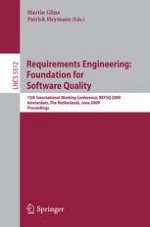2009 | Book
Requirements Engineering: Foundation for Software Quality
15th International Working Conference, REFSQ 2009 Amsterdam, The Netherlands, June 8-9, 2009 Proceedings
Editors: Martin Glinz, Patrick Heymans
Publisher: Springer Berlin Heidelberg
Book Series : Lecture Notes in Computer Science
